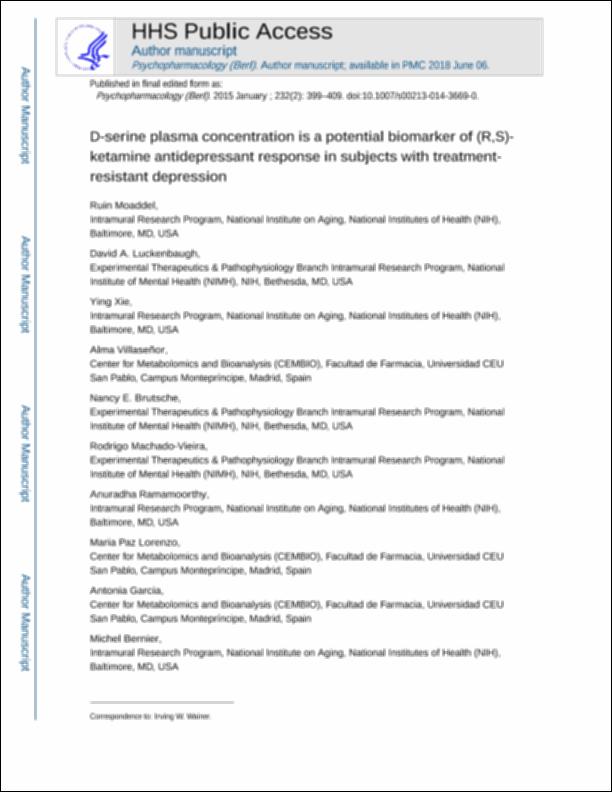Por favor, use este identificador para citar o enlazar este ítem:
http://hdl.handle.net/10637/13001D-serine plasma concentration is a potential biomarker of (R,S)-ketamine antidepressant response in subjects with treatment-resistant depression.
| Título : | D-serine plasma concentration is a potential biomarker of (R,S)-ketamine antidepressant response in subjects with treatment-resistant depression. |
| Autor : | García Fernández, Antonia Villaseñor Solis, Alma Cristina Moaddel, Ruin Barbas Arribas, Coral. Lorenzo García, María Paz |
| Materias: | (R,S)-ketamine; Antidepressant; Treatment-resistant depression; Bipolar depression; D-serine; Nmethyl-D-aspartate receptor; Serine racemase; Plasma response marker |
| Resumen : | Rationale—(R,S)-ketamine is a rapid and effective antidepressant drug that produces a response in two thirds of patients with treatment-resistant depression (TRD). The underlying biochemical differences between a (R,S)-ketamine responder (KET-R) and non-responder (KET-NR) have not been definitively identified but may involve serine metabolism. Objectives—The aim of the study was to examine the relationship between baseline plasma concentrations of D-serine and its precursor L-serine and antidepressant response to (R,S)- ketamine in TRD patients. Methods—Plasma samples were obtained from 21 TRD patients at baseline, 60 min before initiation of the (R,S)-ketamine infusion. Patients were classified as KET-Rs (n=8) or KET-NRs (n=13) based upon the difference in Montgomery–Åsberg Depression Rating Scale (MADRS) scores at baseline and 230 min after infusion, with response defined as a ≥50 % decrease in MADRS score. The plasma concentrations of D-serine and L-serine were determined using liquid chromatography-mass spectrometry. Results—Baseline D-serine plasma concentrations were significantly lower in KET-Rs (3.02±0.21 μM) than in KET-NRs (4.68±0.81 μM), p<0.001. A significant relationship between baseline D-serine plasma concentrations and percent change in MADRS at 230 min was determined using a Pearson correlation, r=0.77, p<0.001, with baseline D-serine explaining 60 % of the variance in (R,S)-ketamine response. The baseline concentrations of L-serine (L-Ser) in KET-Rs were also significantly lower than those measured in KET-NRs (66.2 ± 9.6 μM vs 242.9 ± 5.6 μM, respectively; p<0.0001). Conclusions—The results demonstrate that the baseline D-serine plasma concentrations were significantly lower in KET-Rs than in KET-NRs and suggest that this variable can be used to predict an antidepressant response following (R,S)-ketamine administration. |
| Descripción : | Artículo en colaboración con: David A. Luckenbaugh, Ying Xie, Alma Villaseñor, Nancy E, Brutsche, Rodrigo Machado-Vieira, Anuradha Ramamoorthy, María Paz Lorenzo, Antonia Garcia, Michel Bernier, Marc C. Torjman, Coral Barbas, Carlos A. Zarate, Irving W. Wainer En: Psychopharmacology. ISSN 0033-3158 2015, 232, 2: 399 - 409 |
| URI : | http://hdl.handle.net/10637/13001 |
| Derechos: | http://creativecommons.org/licenses/by-nc-nd/4.0/deed.es |
| Fecha de publicación : | 15-sep-2015 |
| Centro : | Universidad San Pablo-CEU |
| Aparece en las colecciones: | Facultad de Farmacia |
Los ítems de DSpace están protegidos por copyright, con todos los derechos reservados, a menos que se indique lo contrario.


